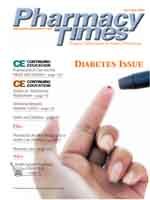Publication
Article
Pharmacy Times
Test Foretells Limb Loss
The hemoglobin A1C (HbA1C) blood test can predict whether partial foot amputationwill succeed in diabetics with foot ulcers or whether a below-the-knee amputation will benecessary, according to the findings of a study presented at the American OrthopaedicFoot and Ankle Society's annual meeting (July 29, 2004). Although the finger-stick testdiabetics take every day gives a blood-sugar value for that moment, the HbA1C testgives a more long-term assessment of how sugar levels have been controlled over severalmonths. A majority of laboratories consider HbA1C values between 3% and 6% asnormal.
In the current study, the researchers compared data from 21 patients with a failed partialfoot amputation and 21 similar patients with a successful amputation. Age, sex,smoking, pulse in the foot, and HbA1C were factored into the study. The results showedthat an HbA1C value of >10% strongly indicated that a partial foot amputation would failto heal, compared with values of <7% that usually forecast success. Lead researcherAlastair Younger, MD, stressed, however, that a high HbA1C should not result in an automaticbelow-the-knee amputation. Instead, surgeons should refer the patient to anendocrinologist or take other steps to improve sugar level prior to surgery.







